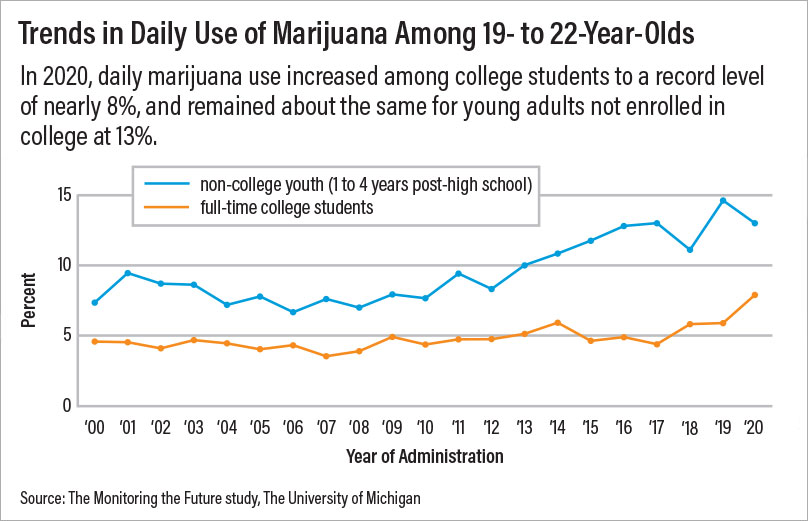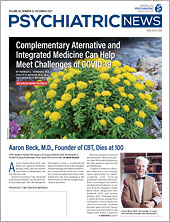Drug use trends have shifted dramatically among young adults, with use of marijuana and hallucinogens reaching historically high levels in recent years, according to a 2020 Monitoring the Future (MTF) panel study.
Marking the highest levels recorded since the 1980s, 44% of college students reported past-year marijuana use in 2020, up from 38% in 2015. Prevalence was similar for young adults who were not enrolled in college, with 43% reporting past-year use.
Daily or near-daily use of marijuana also rose significantly for college students to 8%, up from 5% in 2015. Among young adults not enrolled in college, 13% reported daily or near-daily use.
Young adults aged 19 to 22 were surveyed for the panel study between March and November 2020—when much of the nation was in pandemic lockdowns and virtual school.
“As of 2020, almost 1 in 12 college students used marijuana on a daily basis. We know from our research and that of others that heavy marijuana use is associated with poor academic performance and dropping out of college,” said John Schulenberg, Ph.D., research professor at the University of Michigan’s Institute for Social Research and MTF panel study lead investigator. “For the almost 1 in 7 young adults aged 19 to 22 not in college who are daily marijuana users, getting a foothold on the roles and responsibilities of adulthood may be all the more difficult.”
Psychiatrists: Discuss Marijuana Risks With Patients
Elie G. Aoun, M.D., an assistant professor of clinical psychiatry at Columbia University, told Psychiatric News that the changes in marijuana use have been unfolding for the past 10 to 15 years.
“Marijuana is easier to use without detection than alcohol, particularly the edible and vaped forms of the drug. It may also be easier for young adults to obtain,” he added. Many states allow marijuana use starting at age 18 for those with a medical marijuana card, which Aoun said can be easily obtained for a fee from virtual providers online. A growing number of states (19 plus the District of Columbia) also allow recreational use of marijuana by those ages 21 and older.
Aoun said the medical benefits of marijuana have been overstated, and as a result, many young patients mistakenly believe that marijuana use is “healthy.”
“People use it as a drug because they want to achieve a state of feeling high and of feeling pleasure. That can be a personal choice. But it doesn’t come without costs.” He noted that marijuana use may cause sleep disturbances; cognitive distress; reduced motivation and energy; memory difficulties; poorer performance at work and school; and for those with psychiatric disorders, deteriorating psychiatric symptoms.
Aoun said that psychiatrists may be reluctant to discuss use of marijuana with patients because of the drug’s history as a tool for racial oppression as part of the War on Drugs. “Our job as a medical community is to make sure accurate information [about marijuana] is out there. We need to talk, talk, talk with our patients and have honest conversations about marijuana use.
“We can apply the same model with our patients that we use with alcohol: Recognize that it’s not necessarily a bad thing [for people] to use marijuana, but it can be problematic when they’re having consequences, when they have an addiction, or when they’re using it because they’re too depressed or anxious.”
1 in 10 Use Hallucinogens
The survey reported that annual use of hallucinogens—including LSD, psilocybin, mushrooms, and other psychedelic substances—reached its highest level since 1982 among college students: nearly 9% in 2020, up from 5% the prior year. Among young adults not in college, annual hallucinogen use was 10% in 2020, its highest level in two decades.
Aoun said he is concerned about the significant rise in the use of substances as a tool for self-medicating. “There appears to be a rise in individuals using drugs to function, to feel normal.” Rather than referring to the use of hallucinogens as a way of “getting high,” he hears young adults and the media speak about having “spiritual” or “mystical” experiences with these substances or growing their own “artisanal” mushrooms. This lends these substances an intellectual, elitist flair, which may be increasing their allure. “You would never hear anyone talk about cocaine, heroin, or meth in the same way.”
Furthermore, music festivals that promote the use of hallucinogens are growing more commercialized and mainstream, he added. Finally, the FDA’s approval of esketamine in 2019 for the treatment of refractory depression leads some substance users to incorrectly extrapolate that every psychedelic drug is an effective psychotherapeutic, even though there are not data to support that, he said.
Alcohol Use Drops
College students reported significantly lower alcohol use across numerous measures in 2020 compared with the previous year, which may reflect reduced time with college friends due to the pandemic, Schulenberg and colleagues said. For example, 56% of students reported using alcohol in the past 30 days in 2020 (down from 62% the prior year), and 28% reported being drunk in the past 30 days (down from 35%). The survey revealed a new low: 24% of college students reported binge drinking, which is defined as consuming five or more alcoholic drinks in a row at least once in the past two weeks, down from 32% in 2019.
Among young adults not in college, trends in alcohol use across all measures have been stable over the past five years, with about half of the respondents reporting alcohol use in the past 30 days, 22% reporting being drunk in the past 30 days, and 24% reporting binge drinking at least once in the past two weeks.
MTF is funded by the National Institute on Drug Abuse. ■
“Monitoring the Future National Survey Results on Drug Use 1975-2020” is posted
here.

